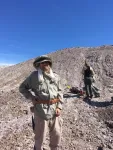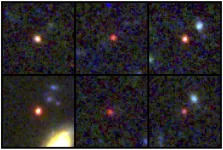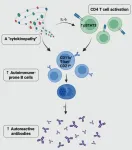(Press-News.org) Scientists continue to refine techniques for understanding present-day changes in Earth’s environmental systems, but the planet’s distant past also offers crucial information to deepen that understanding. A geological study by University of Nebraska–Lincoln scientist Matt Joeckel and colleagues provides such information.
Scientific research in recent decades has confirmed that major changes in the global carbon cycle caused significant changes in the Earth’s atmosphere and oceans 135 million years ago, during the early Cretaceous Period. A range of questions remain about the details of climate change dynamics in that era. This new research, involving wide-ranging chemical and radioactivity-based analyses of rock strata in Utah’s Cedar Mountain Formation, helps fill in that knowledge gap by confirming that such carbon-cycle shifts were recorded on land in ancient North America.
The carbon cycle is one of Earth’s fundamental environmental phenomena, involving the ongoing transfer of carbon among the atmosphere, oceans and living organisms, as well as soils, sediments and rocks in the solid Earth. The cycle is crucial to biological processes for living things on land and sea. When large-scale changes in the cycle occur, they can produce major shifts in climate and the oceans’ biological conditions.
“We’re studying how the global carbon cycle has functioned in the past, how changes are recorded in the sedimentary rocks around the world,” said Joeckel, a professor in the School of Natural Resources at Nebraska. The environmental phenomena he and his colleagues analyzed “are exactly the kind of things we’re talking about today, as people increase the input of carbon dioxide into the atmosphere at a much-accelerated rate by burning fossil fuels.”
Joeckel, the Nebraska state geologist, headed the Utah fieldwork and organized the study, published as a peer-reviewed paper in a special February issue of the journal Geosciences.
Over the past two decades, Joeckel and several colleagues have studied a range of geological aspects of southeastern Utah’s Cedar Mountain Formation, known for its exceptional dinosaur fossils. The steep, 150-foot slope where the scientists conducted their recent carbon-cycle research is known as Utahraptor Ridge, named for the discovery there of raptors, the ferocious bipedal predators familiar to moviegoers through the Jurassic Park movies.
To determine whether carbon-cycle changes have occurred, scientists analyze the minute amounts of organic carbon held in rocks for major changes in two carbon isotopes. Carbon cycles are evident if scientists find that significant increases and decreases in isotope ratios occurred over time. Joeckel and his colleagues found evidence for two distinct peaks in a curve representing changes in a key isotope ratio during the early Cretaceous period. This discovery indicates that the Utah site, though on land, experienced the same major carbon-cycle change recorded in marine sedimentary rocks in Europe.
Many geologists refer to this ancient carbon-cycle phenomenon as the “Weissert Event,” which was driven by large, sustained volcanic eruptions in the Southern Hemisphere. These eruptions greatly increased carbon dioxide levels in the atmosphere, producing significant greenhouse climate effects over a prolonged time.
A central uncertainty has been whether carbon-cycle changes recorded in sediments in ancient oceans were also recorded by sediments on land. The work by Joeckel and his colleagues strongly suggests that happened.
Analyzing the Utah samples for these carbon isotope changes was a challenging scientific endeavor, said Joeckel, director of Nebraska’s state Conservation and Survey Division, which conducts a wide array of geological, geographic, water and soil research in the state and beyond.
“We’re talking about a minute amount of organic carbon that has to be very laboriously isolated from fist-sized samples of sedimentary rock,” he said. Such complex work is “like having to go through a whole pile of phone books by hand just to get to the point where you can generate numbers, and you have to generate a lot of them. There’s a lot of hard work in the laboratory that needs to be done.”
To accurately date the carbon-cycle changes, the scientists also analyzed microscopic crystals of the mineral zircon. These crystals “are important because they are a way to actually put an age date on the rocks,” Joeckel said. The volcanically produced zircon crystals are “nearly indestructible treasure troves of information that are spread all over the place” after an eruption.
Joeckel’s coauthors on the paper are Celina Suarez and Garrett Hatzell of the University of Arkansas; Noah McLean, Andreas Möller, Marina Suarez and Joseph Andrew of the University of Kansas; Gregory Ludvigson and Spencer Kiessling of the Kansas Geological Survey; and James Kirkland of the Utah Geological Survey.
The project, Joeckel said, illustrates how geology as a discipline continues to reveal new insights.
“In some ways, the past may be the key to the present, rather than vice versa, as geologists traditionally posited,” he said. “The better we understand the ancient carbon cycle and ancient global change, the more we can understand what happens today.”
END
Early Cretaceous shift in the global carbon cycle affected both land and sea
New study deepens understanding of present-day changes in Earth's environmental systems
2023-02-22
ELSE PRESS RELEASES FROM THIS DATE:
Discovery of massive early galaxies defies prior understanding of the universe
2023-02-22
UNIVERSITY PARK, Pa. — Six massive galaxies discovered in the early universe are upending what scientists previously understood about the origins of galaxies in the universe.
“These objects are way more massive than anyone expected,” said Joel Leja, assistant professor of astronomy and astrophysics at Penn State, who modeled light from these galaxies. “We expected only to find tiny, young, baby galaxies at this point in time, but we’ve discovered galaxies as mature as our own in what was previously understood to be the dawn of the universe.”
Using the first dataset released from NASA's James Webb Space Telescope, ...
Mechanisms underlying autoimmunity in Down syndrome revealed
2023-02-22
New York, NY (February 22, 2023) – Scientists at the Icahn School of Medicine at Mount Sinai in New York have identified which parts of the immune system go awry and contribute to autoimmune diseases in individuals with Down syndrome. The findings published in the February 22 online issue of Nature [DOI: https://doi.org/10.1038/s41586-023-05736-y].
The work adds to the research team’s findings published in the journal Immunity in October 2022, showing that people with Down syndrome have less frequent but more severe viral infections.
Studying lab specimens from volunteers with Down syndrome, the investigators identified cytokines and a B cell subtype—key ...
Patients identified as frail before surgery less likely to die one year after
2023-02-22
PITTSBURGH, Feb. 22, 2023 – New research published today in JAMA Surgery shows that when frail patients are connected to resources, including conversations with a physician about possible outcomes and help preparing their body for surgery, they are less likely to die one year after surgery.
While age can be an important indicator of a patient’s likelihood of encountering adverse outcomes or complications of surgery, it does not provide a full picture of their health. Frailty considers the patient’s overall well-being, including their physical and cognitive abilities, as well as their body’s ability to recover from surgery.
“Frailty ...
Association of pandemic with unsafe living situations, intimate partner violence among pregnant individuals
2023-02-22
About The Study: This study found an overall increase in unstable and/or unsafe living situations and intimate partner violence (IPV) between January 2019 and December 2020, with a temporary increase associated with the COVID-19 pandemic. It may be useful for emergency response plans to include IPV safeguards for future pandemics. These findings suggest the need for prenatal screening for unsafe and/or unstable living situations and IPV coupled with referral to appropriate support services and preventive ...
Incidence of aggressive end-of-life care among older adults with metastatic cancer in nursing homes and community settings
2023-02-22
About The Study: The results of this study suggest that despite increased emphasis to reduce aggressive end-of-life care in the past several decades, such care remains common among older persons with metastatic cancer and is slightly more prevalent among nursing home residents than their community-dwelling counterparts. Multilevel interventions to decrease aggressive end-of-life care should target the main factors associated with its prevalence, including hospital admissions in the last 30 days of life and in-hospital death.
Authors: Siran M. Koroukian, Ph.D., of the Case Western Reserve University School of Medicine in Cleveland, is the corresponding ...
Rising river temperatures hold important clues about climate and other human impacts
2023-02-22
An improved global understanding of river temperature could provide an important barometer for climate change and other human activities.
River temperature is the fundamental water quality measure that regulates physical, chemical and biological processes in flowing waters and, in turn, impacts ecosystems, human health, and industrial, domestic and recreational uses by people.
In a comment piece in the new journal, Nature Water, researchers led by the University of Birmingham, UK, and Indiana University, USA, have called for an increased ...
Human body proven to predict mealtimes
2023-02-22
The human body can predict the timing of regular meals, according to a new study from the University of Surrey. The research team also found that daily blood glucose rhythms may be driven not only by meal timing but by meal size.
In the first study of its kind, researchers from Surrey, led by Professor Jonathan Johnston, investigated if the human circadian system anticipates large meals. Circadian rhythms/systems are physiological changes, including metabolic, that follow a 24-hour cycle and are usually synchronised to environmental signals, such as light and dark cycles.
Previous ...
James Webb spots super old, massive galaxies that shouldn’t exist
2023-02-22
In a new study, an international team of astrophysicists has discovered several mysterious objects hiding in images from the James Webb Space Telescope: six potential galaxies that emerged so early in the universe’s history and are so massive they should not be possible under current cosmological theory.
Each of the candidate galaxies may have existed at the dawn of the universe roughly 500 to 700 million years after the Big Bang, or more than 13 billion years ago. They’re also gigantic, containing almost as many stars as the modern-day Milky Way Galaxy.
“It’s ...
Climate ‘spiral’ threatens land carbon stores – study
2023-02-22
The world’s forests are losing their ability to absorb carbon due to increasingly ‘unstable’ conditions caused by humans, a landmark study has found.
Dramatic changes to forests, and other habitats that store carbon in plants and soils, are becoming more likely in some regions across Earth, with less carbon consistently absorbed by the ‘land carbon sink’ provided by trees, soil and plants, according to scientists writing in Nature.
The short-term impacts of rising temperatures, ...
Anti-dust tech paves way for self-cleaning surfaces
2023-02-22
Dust is a common fact of life, and it's more than just a daily nuisance – it can get into machinery and equipment, causing loss of efficiency or breakdowns.
Researchers at The University of Texas at Austin partnered with North Carolina-based company Smart Material Solutions Inc. to develop a new method to keep dust from sticking to surfaces. The result is the ability to make many types of materials dust resistant, from spacecraft to solar panels to household windows.
The research is published in ACS Applied Materials & Interfaces.
"What we've ...
LAST 30 PRESS RELEASES:
Manta rays create mobile ecosystems, study finds
Study: Mixed results in using lipoic acid to treat progressive multiple sclerosis
Norbert Holtkamp appointed director of Fermi National Accelerator Laboratory
New agentic AI platform accelerates advanced optics design
Biologists discover neurons use physical signals — not electricity — to stabilize communication
Researchers discover that a hormone can access the brain by hitchhiking
University of Oklahoma researcher awarded funding to pursue AI-powered material design
Exploring how the visual system recovers following injury
Support for parents with infants at pediatric check-ups leads to better reading and math skills in elementary school
Kids’ behavioral health is a growing share of family health costs
Day & night: Cancer disrupts the brain’s natural rhythm
COVID-19 vaccination significantly reduces risk to pregnant women and baby
The role of vaccination in maternal and perinatal outcomes associated with COVID-19 in pregnancy
Mayo Clinic smartwatch system helps parents shorten and defuse children's severe tantrums early
Behavioral health spending spikes to 40% of all children’s health expenditures, nearly doubling in a decade
Digital cognitive behavioral treatment for generalized anxiety disorder
Expenditures for pediatric behavioral health care over time and estimated family financial burden
Air conditioning in nursing homes and mortality during extreme heat
The Alps to lose a record number of glaciers in the next decade
What makes a good proton conductor?
New science reporting guide published for journalists in Bulgaria
New international study reveals major survival gaps among children with cancer
New science reporting guide published for journalists in Turkey
Scientists develop a smarter mRNA therapy that knows which cells to target
Neuroanatomy-informed brain–machine hybrid intelligence for robust acoustic target detection
Eight SwRI hydrogen projects funded by ENERGYWERX
The Lundquist Institute and its start-up company Vitalex Biosciences Announces Strategic Advancement of Second-Generation fungal Vaccine VXV-01 through Phase 1 Trials under $40 Million Competitive Con
Fine particles in pollution are associated with early signs of autoimmune disease
Review article | Towards a Global Ground-Based Earth Observatory (GGBEO): Leveraging existing systems and networks
Penn and UMich create world’s smallest programmable, autonomous robots
[Press-News.org] Early Cretaceous shift in the global carbon cycle affected both land and seaNew study deepens understanding of present-day changes in Earth's environmental systems





